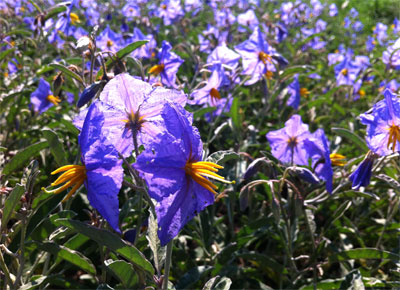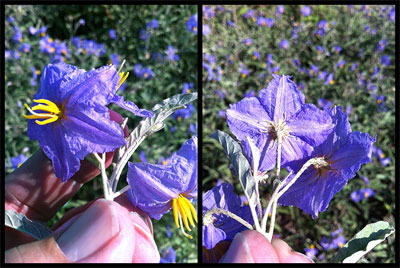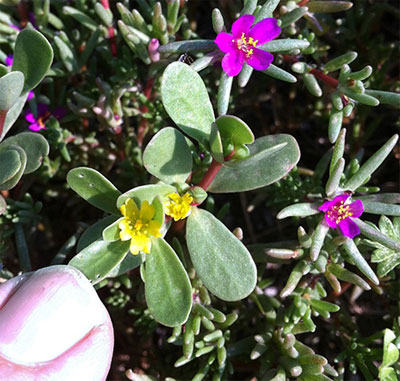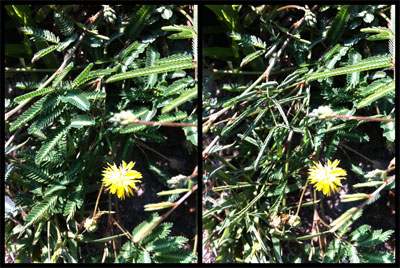Native Son: Getting Low

A colony of silverleaf nightshade becomes bar ditch beauty. Photos by Steven Chamblee.
Late August in Texas … that time of year when I’ve been so hot for so long that my mind begins to melt like butter on a sizzling sidewalk. Like the butter, my brain separates into different stuff…. The clear stuff thinks, “Why in heaven’s name do I not move to Oregon?” The sinking stuff just wants to die and get it over with — and, fortunately, the floaty chunk stuff focuses on the amazing little miracles that can be found in the natural furnace we call “outside.”
I take a little drive out to Mineral Wells to do some banking, and stop at a car wash. My poor ol’ truck hasn’t had a bath since bluebonnet season, which is okay, except the “honeydew glaze” has gotten so thick on the windshield that the wipers just kind of smear it around into an oleaginous mess that reminds me of a syrupy plate after one of my famous blueberry pancake breakfasts. The science part of my brain finds this interesting … plant juice is pressurized in leaves, and this pressure literally blasts the juice through the rudimentary digestive systems of aphids and other insects when they pierce a plant leaf to feed. The “final product” comes down to earth as a sticky mist that adheres amazingly well to anything below, particularly windshields. Once my windshield is clean, I discover that I need my sunglasses again. (I can visualize Neil’s office manager, Gretchen, crinkling her nose and going “eeeewww” as she reads this.)
Now that the pressure washer and the “miracle foamy brush” have restored my driving vision, I begin to spot those little botanical miracles along the roadside … like that patch of silver-leaf nightshade up ahead.

Left photo: Close inspection reveals the intricacy of silverleaf nightshade blossoms. Right photo: Tiny prickles guard the starfish embossment.
You gotta give credit where credit is due, and anything that can grow up through cracks in old road shoulder asphalt and put on a dazzling floral display in a Texas August is pretty amazing. Off-hand, silver-leaf nightshade (Solanum elaeagnifolium) is just a foot-tall mound of silvery-gray foliage topped with bluish-purple blooms. But there’s much more to this beauty than that. If you look closely at the blossom, you will see that the delicate, tissue-thin petals are fused and pleated, with a five-armed starfish pattern embossed upon the corolla (collective term for flower petals … or, a car). The beautiful corollas also change color: pale blue when backlit and purple when lit from the front. The stamens are screaming yellow, and they possess one of the secret wonders of the plant world … they are buzz pollinated.
Buzz pollination is an amazing phenomenon that allows nectarless flowers to attract pollinators by rewarding them with copious amounts of pollen … but only if they know the secret. The anthers (male parts) that contain the pollen are tight cones that release pollen in response to a certain vibration frequency. Bumblebees and other pollinators can vibrate their flight muscles to this frequency, thus releasing the pollen for the insect to collect … and to pollinate the pistil (female part).
“Amazing” is just par for the course in Solanaceae, the nightshade family. This incredibly diverse plant family includes edibles (tomatoes, potatoes, chili peppers), ornamentals (Petunia, Calibrachoa, Nierembergia), smokeables (tobacco), and some of the most toxic plants on the planet (jimsonweed, black henbane, and the beautiful, yet deadly Belladonna). While silver-leaf nightshade is a lovely ornamental wildflower, it is also decidedly poisonous to humans and livestock. Such is the case with Datura (angel’s trumpet/moonflower), most ground cherries (Physalis), and potato leaves. The guideline here is the same for all plants: don’t eat it unless you are sure it’s food.

Native shaggy portulaca thrives on a cracked asphalt road.
Not far away from this pretty patch of purple-petalled poisonous plants are some real ground-hugging beauties that escape the eye of most people. Shaggy portulaca (Portulaca pilosa) is a 1.5-inch-tall carpet of tiny, cigar-shaped leaves accented by quarter-inch-wide purple blossoms. And yes, it is a native Texas relative of the larger flowered ornamental portulacas. It is entwined with a close relative, common purslane (P. oleracea), which is a cute little wildflower, a weed of worldwide infamy, or a simple potherb, depending upon your point of view.

Tiny blossoms on roadside purslane and portulaca.
Just a few feet away, another fun plant called yellow-puff (Neptunia lutea), thrives in the heat. Closely resembling its more famous cousin, pink sensitive briar, in both growth habit (low and sprawling to 10 feet wide) and that finely divided foliage, yellow puff has a yellow blossom (duh) and lacks those numerous, make-you-beg-for-sweet-mercy catclaw prickles that give the pink sensitive briar its other name … which cannot be printed in a family publication such as this. Yellow puff does indeed perform the “I-will-fold-my-leaves-if-you-touch-me” trick (scientifically known as “thigmonasty”), and, in my humble opinion, should be grown at every elementary school in the country. (Unless you don’t want your third grader asking you the difference between “thigmonastic” and “thigmotropic…”)

Left photo: Yellow puff with undisturbed foliage. Right photo: Yellow puff leaves have collapsed after a light touch.
An ache in my back prompts me to rise from all of this Lilliputian botanical bliss, and I immediately notice two things: I am covered in sweat and there is a police cruiser pulled in behind my truck. I go right over and initiate a conversation with the obviously wary officer, who ignores my pleasantries and asks me if I need medical attention. I’m stunned. He gets out and walks over to the yellow puff area and looks around carefully, then asks me who or what I was talking to. I smile and laugh, but he doesn’t. I show him the closing-leaf trick, but he lacks the amazed expression I always get from third-graders when I show them. I tell him I’m thinking about writing an article about “getting low” because of the double meaning with the small plants and it being so hot that I feel like death is near. He tells me “getting low” doesn’t mean close to death anymore; nowadays it’s some kind of lewd dance term. He’s not smiling, either.
In desperation, I say I am “working on an article for Neil Sperry, and”… apparently, those are the magic words. He tells me his mom is a big fan and has been for years. He asks me if I’ve been to Clark Gardens. I ask him if he has been to Chandor Gardens. I show him the photos I’ve been taking while we are strolling back to the truck, and I pull out a few issues of Neil’s magazine for him to take to his mom. (Thank you, Gretchen!) As we part company, he says he’s glad I’m all right, and explains that most of the big ol’ sweaty guys he finds parked by the highway, bent over in a bar ditch, talking to the ground … well, they’re not horticulturists.
About the author: Steven Chamblee is the chief horticulturist for Chandor Gardens in Weatherford and a regular contributor to Neil Sperry’s GARDENS magazine and e-gardens newsletter. Steven adds these notes:
It may be hot outside, but it’s always cool to visit Chandor Gardens. Come see caladiums, gardenias, hibiscus, zinnias, and lots more revel in the Texas summer. Go to www.chandorgardens.com for details. Just take I-20 west to exit 409, hang a right, go 2.1 miles and hang a left on Lee Avenue. Head straight 12 blocks and you’re driving in the gates. Call 817-361-1700 for more information.
I can always use another road trip! Let me know if you’d like me to come out and speak to your group sometime. I’m low-maintenance, flexible, and you know I like to go just about anywhere. No city too big; no town too small. Just send me an e-mail at stevenchamblee@yahoo.com and we’ll work something out.

